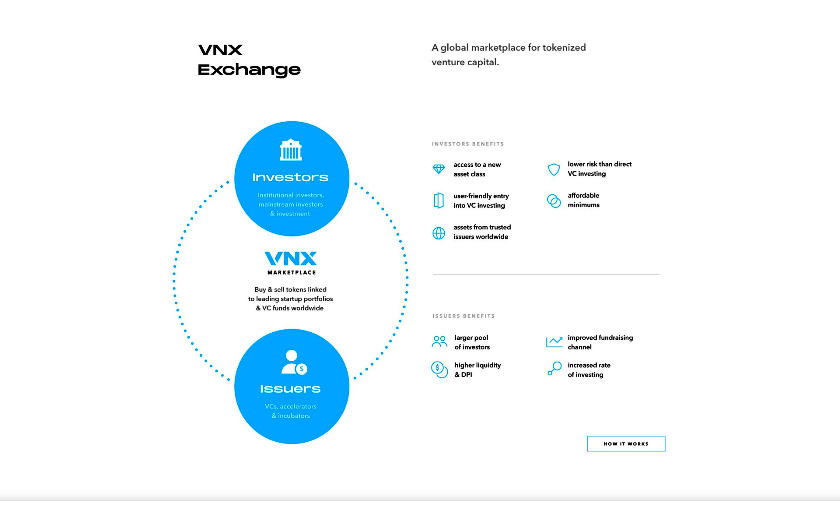VNX Exchange is a financial marketplace (conceptually similar to a classic stock exchange) that will interlink several types of customers (supply side and demand side).

So, the supply side is represented by inventory providers — venture capital (VC) funds, startup accelerators, and other types of venture investors that are issuing digital (blockchain) tokens on the VNX platform, linked to the future incomes from their investment portfolios (usually, exit proceeds from selling equity stakes in startups held by the inventory provider).
These VC tokens are essentially tokenised financial instruments (like a bond, or a futures contract) that will pay token holders a share of the future incomes of the VC portfolio being tokenised and sold on the VNX platform.
These tokens will be listed and traded on the VNX platform.
The demand side is represented by liquidity providers — investors (both professional and main street investors), that are buying, holding, and selling VC tokens on the VNX platform. Liquidity providers are divided into two categories:
The VNX platform operates in the following way:
The VNX platform operates as a marketplace that allows VCs to get additional liquidity in exchange for a share in the future profits. This in turn improves the capital velocity and economics of VC investing, reducing capital lock in from 12 to 14 years to just two to three years, making venture investment more attractive as an asset class, opening it up to a much wider global investor base.
Our analysis shows that the increased capital turnaround and liquidity not only improve return on investment (ROI) for VCs and LPs investing in them, but creates better conditions for competition and market growth. It also has significant ripple effects, such as higher transparency, better governance, real-time asset valuation that leads to higher capital availability, especially for smaller and medium VC players, thus democratising venture investing. As a result, this will empower more VC investors to actively invest into new startups as well extend their support to existing portfolio companies that they previously invested in.
Why use blockchain technology and tokenisation for this rather than regular, traditional mechanisms?
We don’t see blockchain as the key essence of our product, and rather treat it as one of the technology layers in our platform that just happens to be the most relevant and up-to-date solutions for some of the problems we are trying to solve. VNX’s core value proposition has little to do with blockchain and is really about enabling an ecosystem and environment that will make an illiquid asset class a liquid one, however we truly believe in the innovative power of blockchain to enable disintermediation and improve efficiency in the capital markets, and we’re leveraging it in a way to empower change.
In VNX’s case we think that the use of blockchain technology and asset tokenisation offers a number of added benefits compared to how traditional capital markets operate:
As a result, transaction, compliance and administration costs can be significantly reduced, while a significant part of processes involved in transactions between different parties become much more efficient and faster (e.g. transaction settlement takes minutes instead of days, reporting and owner registries are generated in a single click).
We think that the cost efficiency plays a key role in enabling liquidity for the VC industry and serves as a major decision factor for VCs to be able to open up their assets for liquidity, as existing capital market instruments (e.g. an IPO on Nasdaq or any major stock exchange) are prohibitively costly for most VC investors (hence, why there are very few examples of publicly listed VC funds).
What’s next for VNX?
Our primary objective as we build our platform is to open up VC as an asset class to a broad investor base. In order to achieve this, we understand that it crucial to give our customers a level of security, reliability and usability that will not only match, but exceed that of existing market platforms — both traditional and new. This means that our marketplace should be properly regulated and built with the highest level of security and trust.
Our major focus now is to develop all the platform infrastructure and frameworks that will allow us to comply with existing regulatory environment to eventually become a fully regulated exchange in the EU. Our ambition is to become the first fully compliant marketplace in EU for trading VC funds. Currently we are in a process of filing for license in Luxembourg in CSSF (Commission de Surveillance du Secteur Financier, the local financial markets regulator), working with a team of lawyers and advisors led by Luc Frieden — former Luxembourg Minister of Finance and Minister of Justice.
In parallel, we are finalising the next version of our trading platform after completing testing and evaluation of our first MVP version that was released in February 2018. This second version of our platform is scheduled to go live in private beta by the end of 2018. The entire product will be launched in 2019 after receiving all necessary regulatory approvals.
Another strategic goal for VNX is creating a robust ecosystem. We have a partnership with Luxembourg University, the leading European centre of blockchain competence, and are in the process of signing partnership agreements with several key players in the blockchain ecosystem, as well as working closely with the first VCs (future issuers) to come to our platform in 2019. We have already secured soft commitments with a number of major players in the European early stage venture investment space, and plan to have at least $1 bln worth of venture portfolios in our listing pipeline by the time we go live in 2019.
Stay informed.
Subscribe to our newsletter